Why You Should
Never
Flush A
Tick
By Elaina Hancock '09 MS
Photos by Peter Morenus
Why You Should
Never
Flush A
Tick
By Elaina Hancock '09 MS
Photos by Peter Morenus
No, it won't grow to gator size and come back to bite you. But taking it to this UConn testing facility could reap some pretty significant rewards.
Another summer in New England, another boom in the tick population. It seems impossible to miss media accounts of how large the population was last year and how much worse it could be this year.
And you would be hard pressed to find someone — or someone who knows someone — who hasn't been impacted by a tick-borne disease. It's even harder to avoid the terrifying headlines about the latest devastating disease and how rampant it is likely to be. Every mention is accompanied by that feeling that something is crawling on your arm, your neck. One could become inured to it.
But it is important not to let the yearly wave of tick stories simply wash over us, warns associate professor of pathobiology Paulo Verardi. "People have become used to ticks as just something we have to deal with. But this is a big deal."
Typically after an attached tick is found, a patient is advised to monitor for flu-like symptoms or a rash for about a week, an understandable tactic considering how common tick bites are.
However, consider a tick is like an eight-legged syringe potentially loaded with multiple pathogens that may or may not be passed to its host while attached. Ticks literally "dig in" while feeding. After cutting the host's skin, a tick will sink its mouthparts into the wound and insert a feeding tube. Some ticks even secrete a cementlike mixture to help them attach even more efficiently. Some diseases are passed quickly; others may take a day or two.
Now consider that some of the diseases that could result from this encounter may have immediate symptoms and others may have symptoms that don't show up for days, weeks, even months. And even with symptoms, some tick-borne diseases are difficult to test for in a patient — they can hide out and evade routine testing techniques.
Finally, consider that some of these infections can carry lasting effects, such as those seen in post-treatment Lyme disease syndrome (PTLDS), ranging from fatigue and malaise to arthritis, carditis, and neurological symptoms.
"Would you rather wait or would you rather know?" asks lab technician Heather Haycock '03 (CAHNR), who works at the Connecticut Veterinary Medical Diagnostic Lab (CVMDL) smack dab in the middle of the UConn campus.
CVMDL is a little-known resource offering powerful data and potential peace of mind for those who have picked ticks off of themselves or loved ones (two- or four-legged loved ones). The lab tests around 600 ticks each year — provided by clients who take the test results to health care providers.
Why have your ticks tested? "Knowledge is power," says lab technician Maureen Sims '06 (CAHNR). The knowledge will get you targeted, appropriate treatment. Or conversely, it will give you peace of mind that the tick you found didn't harbor any nasty pathogens.
"Would you rather wait or would you rather know?"
If you put a tick in a blender...
A recent visit to CVMDL finds Sims leaning over a dissecting microscope, bright lights and lens trained on a specimen that resembles a parched gray watermelon seed. The tick was recently submitted and is ready for identification and testing.
"This one is a female deer tick, and Oh!, she's moving!" Sim's head pops up from the scope and she points out eight legs slowly beginning to stir as the lights from the scope warm and wake the tick up. Stay tuned: There's a far ruder awakening in this tick's near future.
Sims is in charge of the initial steps of tick testing at CVMDL, where she determines the species, the sex, where it is in its life cycle, and the degree of engorgement, which gives an idea of how long the tick was feeding on its host. All of these bits of information help determine how successful the tick may have been in transmitting a litany of diseases to its host.
After the ID, Sims places the tick in a test tube and hands the specimen off to Haycock, who carries on with the processing, first with the ruder awakening — the gruesome job of squishing the tick. She adds a little liquid, then smashes the tick into a brownish-red sludge using a small wooden stick. "This one was pulled off a dog. When they have been pulled off of people, it's worse somehow," opines Haycock.
This sludge is where the genetic information for any pathogens the tick was carrying will be. After extracting the DNA, Haycock runs tests for two species of Borrelia and another common tick-borne pathogen in the Northeast, Anaplasma. Ticks may have feasted on multiple hosts since many ticks, such as the deer tick, require more than one blood meal to complete a life cycle, with each host offering another opportunity to transmit pathogens to the hungry tick.
Consider a tick is like an eight-legged syringe potentially loaded with multiple pathogens that may or may not be passed to its host while attached.
the "new" deadly disease
As a component of the pathobiology and veterinary science department at UConn, CVMDL also serves as the Connecticut State Veterinary Diagnostic Lab. Work with the diagnostic labs and research labs may overlap, expertise is shared, and collaborations are frequent. Within the department, focus tends to be on studying animal diseases. But many of these diseases are shared with the human population, says Guillermo Risatti, associate professor of pathobiology and head of Diagnostic Testing Services at CVMDL. Powassan virus, the newest tick-borne infection to make headlines in Connecticut, is one of those diseases.
Powassan itself is not new. It was first described in the 1950s in a fatal case of encephalitis in a young boy and is in the same family as West Nile and the Zika virus, says Risatti. But humans were seen as more of an incidental host for Powassan, which mostly appeared in woodchucks and was carried by a tick not typically interested in people. Then the virus started to show up in the deer tick population, the same ticks often pulled off people.
Though only one case of Powassan has been reported in Connecticut, there were 21 cases in the U.S. in 2016, and the virus is a serious one. It packs a deadly punch, with a reported 10 percent of cases ending fatally. Powassan is also quick, with transmission in as little as 15 minutes after the tick digs in, unlike the often-touted 24 to 48 hours required for Lyme disease. The third punch Powassan packs is that it has no cure, only supportive treatments can be administered with hopes the patient will pull through.
"This is a public health crisis in the making," says Verardi, who in addition to teaching pathobiology works as a virologist and vaccine developer. He naturally started thinking about a vaccine when news of Powassan in Connecticut broke. Since most of the tick-borne diseases in our area are bacterial and are relatively easily treated, the issue of vaccines for tick-borne diseases had been on his back burner. "With Powassan virus happening right here," he says, "it becomes a big deal."
Now plans are under way to start working on vaccines for both Powassan and Lyme. But vaccine development is a long, expensive process, often involving a lot of trial and error. In the meantime, Verardi and his colleagues here and elsewhere in the Northeast are exploring vaccines for animal hosts. Small rodents, for example, could receive a vaccine that would either block transmission of the pathogens to the tick once it feeds or perhaps kill the tick altogether.
Since Powassan is not a new virus, why are we hearing about it now? It seems like there is a new tick-borne disease popping up every few years. The truth is that you can't test for what you don't know about, and as tick expert and CAHNR associate dean of academic programs Sandra Bushmich puts it, "There are diseases that we do know about that people aren't testing for routinely. Powassan causes encephalitis, and you don't always know the cause of encephalitis, therefore it is probably an underreported illness." It likely has been present in Connecticut much longer than documented, lurking in the animal population and only recently making headlines in the human population.
tick radar
What if there were a way to monitor disease activity before these diseases even had a chance to make their way into the human population? One way to do this is by putting ticks to work for us, and CVMDL has plans to do that. Risatti explains, "Ticks are a big deal for us; they are real-life biosensors," feeding from and sampling wild animal populations, the same animals that may harbor diseases like Powassan. Along with the 500 to 600 ticks submitted each year, typically pulled off humans and domestic animals, there are plenty of ticks hitchhiking their way to CVMDL. "We receive a lot of wildlife submitted for rabies testing," says Risatti, "and they often have ticks on them. What we are doing now is saving those ticks for future testing."
Like old buddies, with ticks come tick-borne pathogens. Tick-borne pathogens persist in the animal population for the most part because they aren't usually fatal to their hosts. If an animal harboring the Powassan virus isn't sickened it will carry on with its life, infecting and ferrying ticks around and acting as a great disease spreader. "These animals will keep the virus in the environment," Risatti warns. As long as the virus remains in growing animal populations, the growing tick population is more likely to carry it.
Just like forecasts for weather, UV levels, or pollen counts, this expanded surveillance data could forecast what diseases might start popping up, and where, in the human population, giving doctors tools to quickly diagnose and treat tick-borne disease infections.
This data will also come in handy for keeping tabs on tick species found here. With different ticks come different or "new" tick-borne pathogens, ones creeping closer to our region, such as Rocky Mountain spotted fever. Powassan isn't the only new disease we should be worried about.
Verardi stresses, "What we have here isn't just a problem with these diseases. What we have here is a problem with ticks!"
So why are ticks such a problem here in the Northeast? The topic, like the ticks, seems to pop up everywhere, and it's hard to avoid because the Northeast happens to be a fantastic place to be a tick. Dr. Bushmich explains, "We're near the ocean and there's more moisture here, making it a favorable climate for ticks." Essentially, we are living among more and more hosts, with fewer predators, in conditions ticks thrive in. As wildlife populations grow and become comfortable with the cushy suburban lifestyle, they will support an ever-growing, ever-hungry tick population.
protect yourself
What can we do to stay safe?
For one thing, we can make our yards less tick friendly. Ticks rely on cool, damp, and dark locations, where they hang out and can keep from drying out. Stone walls, say, are ideal. Fortunately for ticks these habitats are also frequented by squirrels, chipmunks, and mice, who play the roles of a taxi and a source of blood for them to feast on.

For more strategies on protecting yourself and your yard from ticks, visit the UConn Home and Garden Education Center.
Ticks cannot fly or jump, but they are particularly good at hitchhiking, using a behavior called "questing"— clinging to the tips of grass or other vegetation with its rear legs and using its front limbs to grab on to passersby. While the tick hitches a ride and starts chowing down, its rodent host carries on with its life, scurrying about looking for food and making rodent babies. The tick will hang out here until it is full; then it will ditch its current host in search of different host, whether it be another rodent, a dog, a child — you name it. There are few places these rodents and their blood sucking passengers can't access.
Susan Pelton of the UConn Home and Garden Center (HGEC) stresses the importance of eliminating tick and rodent habitats — those cool, dark places they prefer, landscape modification provides a barrier to ticks and can be very effective at managing ticks — use dry wood mulch or crushed stones, not fresh mulch or leaf litter. Maintain clear paths and also provide a dry mulched perimeter around stone walls, plantings, and in areas close to the forest's edge. A fact sheet provided by the HGEC notes that 82 percent of deer ticks found in a yard will be around nine feet from the edge of the nearest wooded area. Keeping yards tidy and increasing sunlight conditions are key strategies. Ask yourself, "Would a tick hate this?" If the answer is yes, do it.
Diseases typically transmitted by ticks in the Northeast*

Lyme caused by Borrelia burgdorferi bacterium
Spread by deer ticks, Lyme disease presents with flu-like symptoms and is typically accompanied by joint pain or discomfort. Though many look for the bull's-eye rash, this is not seen in all cases. Left untreated for days to months, Lyme can lead to arthritis, heart problems, nerve pain, and neurological issues, such as depression and memory troubles. Ticks must be attached for 24 to 48 hours for Lyme disease to be transmitted to the host.

Tick-borne relapsing fever caused by Borrelia miyamotoi bacterium
Spread by deer ticks, this presents with muscle and joint aches and a high fever that often lasts about three days followed by seven fever-free days followed by another three-day high fever. Transmission can happen less than 24 hours after the tick becomes attached.

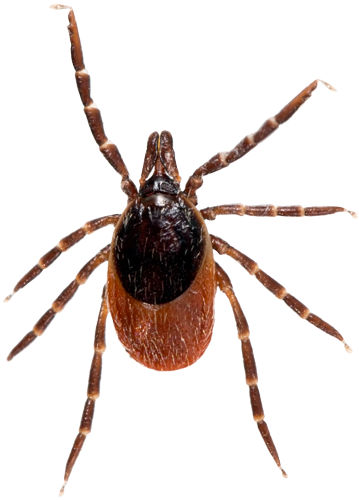
Anaplasmosis
This presents with flu-like symptoms typically within a week or two of being bitten by a deer tick. It is estimated that the pathogen will be transmitted after 24 hours of attachment to the host.
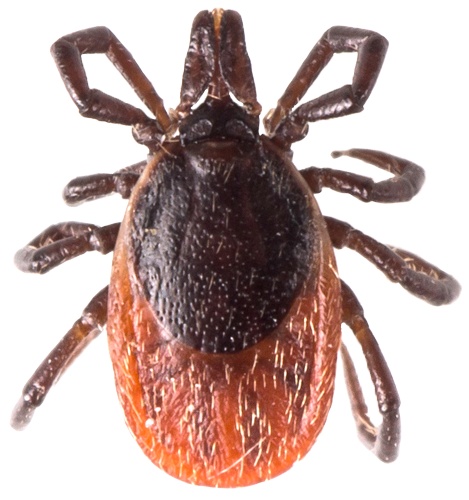
Babesiosis caused by the parasite Babesia
Spread by the deer tick, babesiosis is often asymptomatic. When symptomatic, the illness may present with flu-like symptoms. Ticks must feed for 36 to 48 hours for transmission to host.

Diseases and conditions not yet typically transmitted in the Northeast*
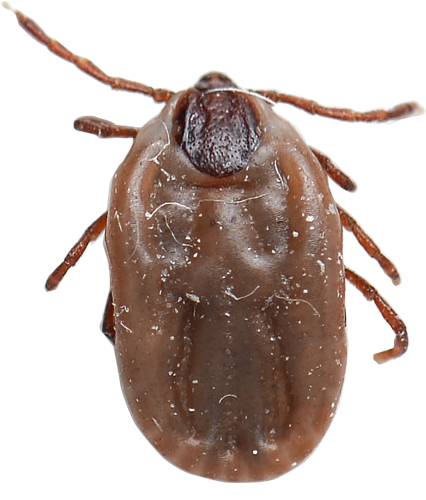
Rocky Mountain spotted fever (RMSF)
Spread by the brown dog tick, dog tick, or Lone Star tick, RMSF is caused by the bacterium Rickettsia rickettsii and can be fatal. The disease typically starts with flu-like symptoms often accompanied by a rash. As many as 20 percent of cases are fatal if untreated; five percent are fatal in treated cases. Estimates vary, but it is suggested the tick needs to feed for 24 hours prior to transmission.
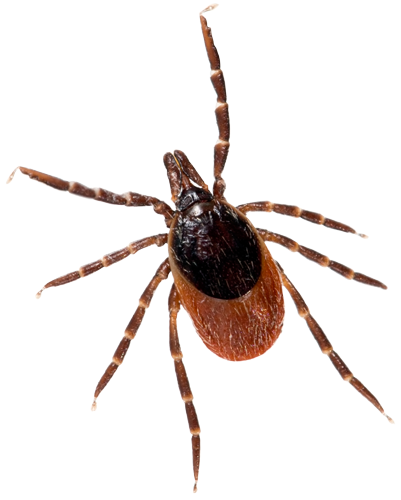
Powassan
Transmitted by the deer tick, and caused by the virus of the same name, the disease is transmitted in as little as 15 minutes after a bite. Symptoms may include fever, headache, encephalitis, confusion, and seizures, to name a few. However, some do not develop symptoms. Those who develop encephalitis may be left with permanent neurological symptoms, and 10 percent of Powassan-caused encephalitis cases are fatal.

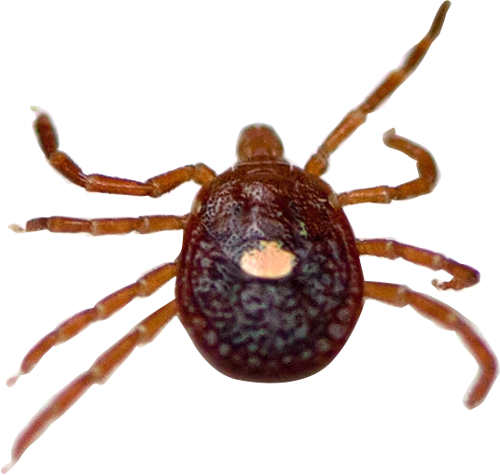
Alpha-gal allergy
If bitten by the Lone Star tick, individuals may develop a severe allergy to mammalian meats (for example, beef and pork). The allergic reaction can occur a few hours after eating the meat and may present with hives, itching, gastrointestinal symptoms, and possible anaphylaxis.
*Information from experts at the Connecticut Veterinary Medical Diagnostic Lab and cdc.gov.
For information about bringing your ticks for testing, please visit cvmdl.uconn.edu
Fees for tick testing at the CVMDL range from $15 for identification only up to $125 depending on tick species, host, and number of pathogens tested for.

Great info although I’m curious as to why the tbd Bartonella was not even mentioned? As I understand Bartonella can often present itself with psychological symptoms and most people aren’t aware that new onset of psych symptoms (i.e. depression, thoughts of suicide, ocd…) can be related to a tick bite!
Hi Cher, great question,
Paulo Verardi, Associate Professor of Pathobiology, answers:
According to the CDC (https://www.cdc.gov/bartonella/testing-faq/index.html) No study in the United States has shown that Bartonella can be transmitted to humans by ticks, therefore it is not tested for at CVMDL.
If you want ticks so you can study them, just say so.
If I send in a tick and I’m told a week later that it carries diseases, but I feel fine, how does that help me?
Thanks, Steve…Cape Cod
I have had lyme disease, as well as four of my dogs, my brother, my mother I lived in Old Lyme in the 70-80’s and I seemed to know more about it then anyone except Polly Marsh who was the first one to recognize the disease that is named lyme disease. Although there is a considerable increase in the number of ticks . it seems that many don’t understand the seriousness of it.
It’s not taken seriously enough and what is even more discouraging is that most primary care docs don’t have training to properly assess and treat it.
So I can get you a ton of ticks. Where do they have to? go My son is a UConn student and I a 1980 UConn Pharmacy Grad. Let me know.
Tick city, Branford CT
See link at bottom of story:
For information about bringing your ticks for testing, please visit cvmdl.uconn.edu
I understand Drexel University College of Medicine is developing a new form of tick testing that will test for pretty much everything ticks carry, not just Lyme and a few co-infections. Do you know when that will be ready and when it is, will UConn be adopting that testing too?
Thank you for your response!
Paulo Verardi, Associate Professor of Pathobiology, says:
My understanding is that these are tests for microbiome studies (research studies, not for diagnostics).
Great article but I would have recategorized the Lone Star tick. It’s here and it is communicating the alpha gal allergy. Its prevalence is seemingly not as high as the top-line diseases but there are multiple cases in CT.
Hi Eric,
Thanks for writing in!
Paulo Verardi, Associate Professor of Pathobiology, says:
Yes, you’re right, lone star ticks were rare but are being submitted increasingly at UConn and the Connecticut Agricultural Experiment Station. Details can be found in this press release (PDF).
Great article….one thing I would add is a list of diagnostic centers in other parts of the country offering the same testing services for those of us alumni who have relocated…
Is there any data on how long the various ticks survive on ones clothing, shoes, etc.?